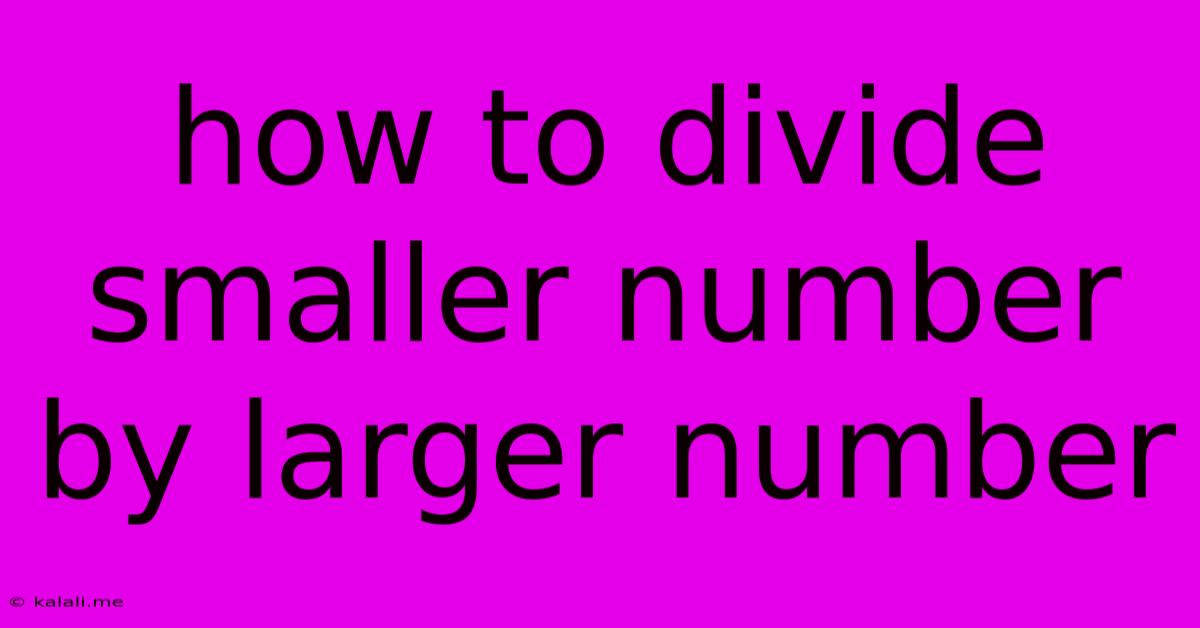How To Divide Smaller Number By Larger Number
Kalali
May 22, 2025 · 3 min read

Table of Contents
How to Divide a Smaller Number by a Larger Number: A Simple Guide
Meta Description: Learn how to easily divide a smaller number by a larger number, understanding the process and interpreting the result as a decimal or fraction. This guide provides clear steps and examples.
Dividing a smaller number by a larger number might seem daunting at first, but it's a straightforward process with a predictable result: a decimal or fraction less than one. This guide breaks down the process into simple, easy-to-understand steps. We'll cover both the long division method and understanding the resulting decimal or fraction.
Understanding the Concept
Before we dive into the mechanics, let's grasp the fundamental concept. When you divide a smaller number by a larger number, you're essentially asking, "How many times does the larger number fit into the smaller number?" Since the larger number won't fit even once completely, the answer will always be less than 1. This answer is represented as either a decimal (e.g., 0.5) or a fraction (e.g., 1/2).
Method 1: Long Division
The traditional method of long division works perfectly well even when dividing a smaller number by a larger number. Here's how:
-
Set up the problem: Write the smaller number (the dividend) inside the long division symbol and the larger number (the divisor) outside.
-
Add a decimal point and zeros: Since the divisor is larger, you won't be able to divide directly. Add a decimal point to the dividend and add zeros as needed. This allows you to continue the division process to find a decimal result.
-
Perform long division: Proceed with the long division process as you normally would. Remember to bring down zeros as required to continue the division until you reach the desired level of accuracy or a repeating decimal pattern.
Example: Divide 3 by 8 (3 ÷ 8)
0.375
8 | 3.000
-24
60
-56
40
-40
0
Therefore, 3 ÷ 8 = 0.375
Method 2: Converting to a Fraction
Another simple approach is to express the division problem as a fraction.
-
Write the division as a fraction: Place the smaller number as the numerator (top) and the larger number as the denominator (bottom). For example, 3 ÷ 8 becomes 3/8.
-
Simplify the fraction (if possible): In this case, 3/8 is already in its simplest form.
-
Convert the fraction to a decimal (optional): To get the decimal equivalent, simply divide the numerator by the denominator using long division (as shown in Method 1).
Interpreting the Result
The result of dividing a smaller number by a larger number will always be:
- A decimal less than 1: This is the most common representation, as seen in our example (0.375).
- A proper fraction: This means the numerator is smaller than the denominator (e.g., 3/8).
Both representations are equally valid and convey the same information. The best choice depends on the context and desired level of precision.
Practical Applications
Understanding how to divide a smaller number by a larger number has practical applications in various fields:
- Calculating percentages: Finding a percentage of a number often involves this type of division.
- Determining proportions: Many proportional relationships require dividing smaller quantities by larger ones.
- Data analysis: Interpreting statistical data frequently necessitates this calculation.
Mastering this fundamental arithmetic skill opens doors to more complex mathematical problems and real-world applications. Practice regularly using different numbers to solidify your understanding and build confidence.
Latest Posts
Latest Posts
-
How To Delete Linkedin Account Without Password
May 22, 2025
-
How To Divide A Small Number By A Big Number
May 22, 2025
-
Reheating A Meat Pie In The Oven
May 22, 2025
-
Is There More Land Or Water On The Earth
May 22, 2025
-
Can You Heat Plates In The Microwave
May 22, 2025
Related Post
Thank you for visiting our website which covers about How To Divide Smaller Number By Larger Number . We hope the information provided has been useful to you. Feel free to contact us if you have any questions or need further assistance. See you next time and don't miss to bookmark.